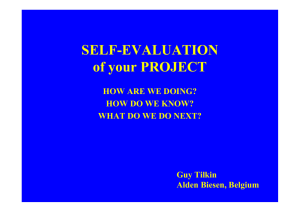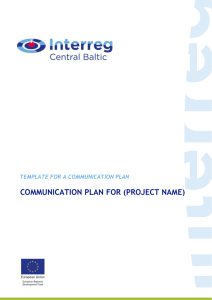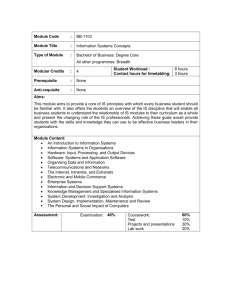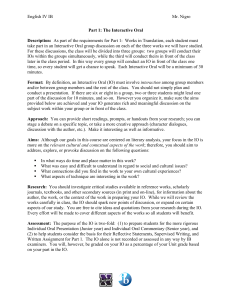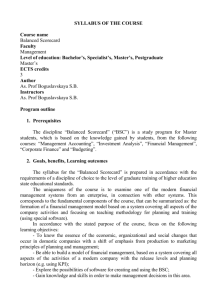project evaluation - MICE
advertisement
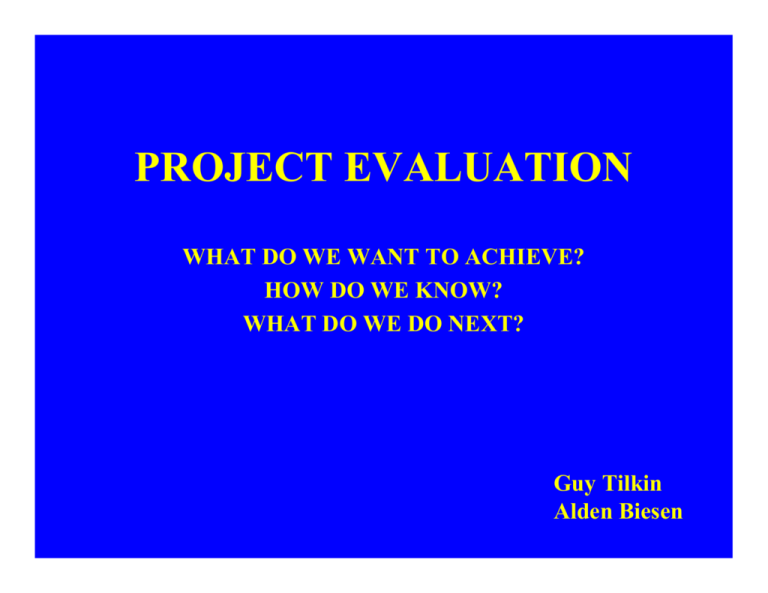
PROJECT EVALUATION WHAT DO WE WANT TO ACHIEVE? HOW DO WE KNOW? WHAT DO WE DO NEXT? Guy Tilkin Alden Biesen INTRODUCTION 1 Evaluation is a process which: • • • • supports a project, by measuring the extent to which the objectives are met, identifies achievements, identifies areas for improvement, encourages decisions to be taken, including changes to objectives and the project methodology. INTRODUCTION 2 Project evaluation involves several steps, related to the stages of the project: • • • • P.S. • • Discussing and defining the aims The collection of data following the objectives of the project and the subject of the evaluation The analysis and the interpretation of this data leading to informed conclusions Amendments of the project in the light of the evidence acquired. It is impossible to evaluate everything. Please select the areas you want to focus on. Effects can be short-term or long-term. INTRODUCTION 3 Evaluation, if present from the outset of a project, can help you to: • • • • • simplify the creation of your project and the consultation with your partners simplify the development of the project show actual proof of what you have achieved, your progress and bring the results and the achievements more to the open simplify the completion of the application forms and the reports improve a current project. EXAMPLE COMENIUS 1 MICE material: evidence of effects and processes • • on four levels: pupils, teachers, school and partnership in several fields of application: subject related knowledge or skills, language skills, ICT skills, motivation, social skills…. • • • • Possible effects Prioritise your objectives Learn to look for indicators Choose your instruments: questionnaires, interviews, group discussion… Decide on who, when (plan) • EXAMPLE COMENIUS 2 MICE-T project: external evaluator Mary Anne Halton Role of the external evaluator: What? Project process, product, impact… How? Instruments When? Meetings (give time to the ex. eval.)… Reports? overall aims of the evaluation (1) 1. 2. 3. 4. 5. To describe and document the MICE-T project (structure, content, implementation, co-ordination, project management). To describe how MICE – T promotes quality self-evaluation of European projects. To determine the quality of the MICE – T project. To examine the extent to which the stated project objectives were realised through the varied activities. To examine the implementation and monitoring of the project at national and transnational level (training teachers and supporting them in the implementation of evaluation of their European projects, thematic workshops). overall aims of the evaluation (2) 6. 7. 8. 9. To identify the key strengths within the different areas of the project and to identify areas which could be developed or improved. To identify any obstacles which may have inhibited the development of the project at national or transnational levels in year 1. To make recommendations for the development of the project in year 2. To acknowledge the work carried out by the project coordinator, the partners and the participating teachers at transnational and national level. + evaluation plan EXAMPLE COMENIUS 3 I-PROBE-NET The I-PROBE NET project wants to create a network on self evaluation at school and further the introduction of a culture of self evaluation at school in two steps: creation of a European network on self evaluation of (European) projects at school spread the culture and techniques of self evaluation to other domains at school. Topics for evaluation Partnership Project process Products Impact on target groups Planning and management Objectives Website International National Composition Monitoring and evaluation Manual(s) Schools/ teachers Commitment/ ownership Working methods Conference(s) Decision makers Co-ordination and leadership Innovative Network Communication Dissemination INDICATORS (How do you know?) • Partnership composition – The partners have close contacts with the target groups. – All relevant levels are present in the partnership. – All relevant types of institutions are present. – All important tasks can be done by the partners. – The geographical spreading is OK. – All objectives can be achieved with these partners. • Communication – The appropriate means for effective communication are available with each partner. – Effective communication takes place on a regular basis. – Material and info is spread effectively. – All used concepts are clear for everybody. – Language competencies are clear and taken into account. – Information between levels flows effectively. INDICATORS • Planning and management – Equality of participation – Clarity of roles and responsibilities – Clear planning and management guidelines – Clarity of organisational guidelines – Clarity of arrangements for meetings and deadlines • Monitoring and evaluation – Evaluation plan – Record keeping and data collection. – Adherence to time scale by partners. – Arrangements for ongoing monitoring. – External evaluation – Review meetings. INDICATORS • The Website – is attractive and invites to further reading – gives the right information on the project / theme – offers an effective communication tool – is well known, easy to find, popular, frequently hit – offers clear information for contacts – offers a handy tool for uploading/publishing • Impact on schools/teachers – The teachers in your region know the material you created – They visit the Website and the discussion forum regularly – They use the material for project evaluation – They are more open for self evaluation – They talk to colleagues about the material and the techniques – Discussions on self evaluation are more open than before INDICATORS • Commitment/ownership – Positive attitude to participation. – Mutual understanding among group. – Willingness to discuss and negotiate. – Strategies to develop teamwork. – Willingness to share roles and responsibilities. – Equality of participation. – Shared ownership among partners. – Promotion of partnership. • Innovative aspects – Appropriate use of ICT. – Didactic approach adapted to the used technologies. – Variety of new approaches. – Development of new material. – Learner centred approach. – Participative approach. – Variety of activities. – Involvement of target groups. – Instalment of learning communities INSTRUMENTS • • • • Questionnaires Interviews Observation Measurement of level of participation • Document analysis • Group discussion • Presentation WHAT’S NEXT ? Implementing changes: • • • • • Interpretation of the evidence Meeting: “What does this mean for us?” Amendment of: objectives, work plan, activity, product, process, communication… Create a special portfolio of evidence gathered (useful for meetings, presentations, final report…). Adopt process and results of the self evaluation in the final report. STEPS • • • • • • • Define and prioritise the aims of the project Define the subject(s) and aims of the evaluation Define the indicators Look for the right instruments Ask the right questions Interpret the material Act accordingly http://www.Alden-Biesen.be http://www.MICE-T.net http://www.I-Probenet.net
